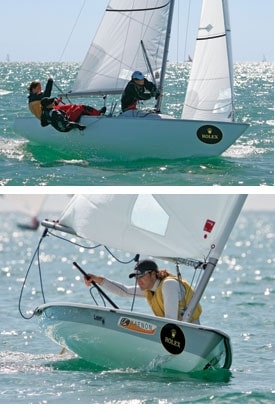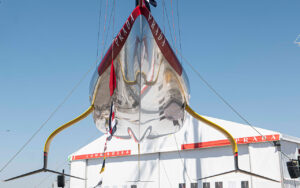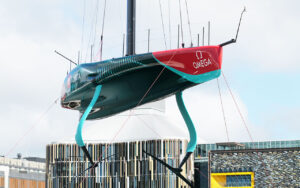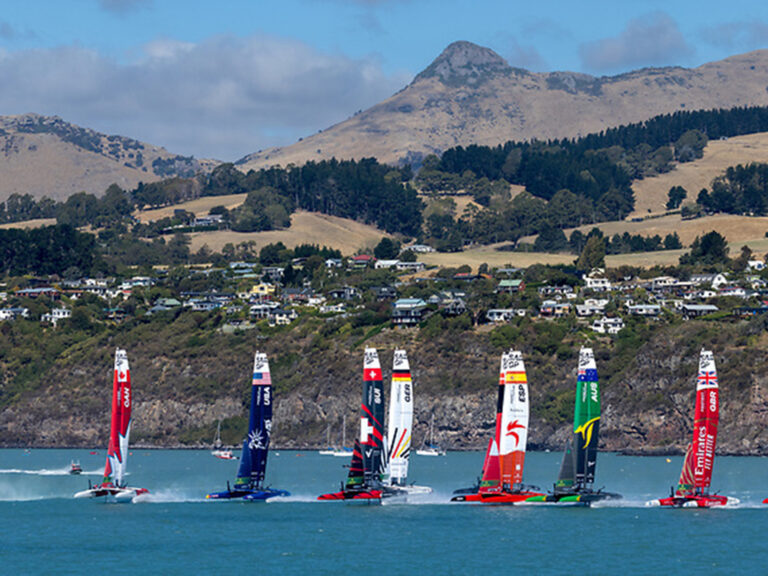
YouthMvmt
In April, U.S. Sailing Team head coach Gary Bodie accompanied a young Yngling team to Europe for the La Semaine Olympique Francaise, the annual French dinghy classic usually known as Hyeres Week. In the sailing instructions was a list of every podium finisher in an Olympic class over the past decade.”You count the number of times a U.S. sailor has made the podium and there’s not many,” says Bodie, looking ahead to his third Olympics as the team’s head coach. “It’s a handful, and it’s big names like Paul Foerster or Johnny Lovell and Charlie Ogletree.”The United States has never fared particularly well in the big European events, especially the year after an Olympic Games, when top U.S. dinghy sailors traditionally recharge batteries and bank accounts. So it’s easy to understand Bodie’s sense of accomplishment when he speaks of the past summer. The Yngling team of Sally Barkow, Carrie Howe, and Debbie Capozzi won at Hyeres and later that summer at the Yngling Worlds in Austria. Other American sailors knocked out four major wins and a number of top-5 finishes, all on foreign waters. “I think it’s pretty safe to say that we’ve never had this good a year internationally in the first year of a quadrennium,” Bodie says. “I’m not trying to take a lot of credit as the coach, I was along for the ride in many senses.”Among the keynote performances were Mikee Anderson-Mitterling and David Hughes’ win in the Men’s 470 division at Kiel Week, a Campbell) and a silver (Anna Tunnicliffe) at the World University Games in Turkey, and Laser Radial victories at the Princess Sophia Regatta and the European Championship by Paige Railey. (For more on Railey and Tunnicliffe, see “To The Head of the Class,” May ’05.)Better yet, all the championships were generated by sailors under the age of 30 and lacking any previous Olympic experience. After two Olympics when the U.S. team was one of the oldest in the marina, there appears to be a changing of the guard in some classes. Of course it’s still early in the Olympic cycle, and experienced sailors will come out of the woodwork over the next two years, jump into abbreviated campaigns, and factor in at the Olympic Trials. But even with the pedal to the medal, these veterans may have a tough time catching up. The team to beatThe 2005 Yngling World Championship was the sort of regatta that could easily drive a sailor insane. In the week preceding the event there was little to no wind on Lake Mondsee, a scrap of water tucked into the edge of the Austrian Alps, east of Salzburg. “We’d planned for 10 days of training,” says Howe, a 24-year-old graduate of Boston College now in her third year of Yngling sailing with Barkow and Capozzi. “We sailed less than 10 hours because the winds were so light. Everyone had a hard time adjusting to sitting on the dock in this small town in Austria.”When the regatta started, the wind was only slightly more cooperative. It died completely in a few races with boats closing in on the finish, leaving the leaders fighting to hold on to their advantage. “It was all just a hunch as to which side would fill in,” says Howe, who saw a pair of top-5 finishes evaporate boatlengths from the finish. “It was all about consistency because you could get a 30th very easily.”This sort of event normally rewards experience. But, the most patient and consistent team was one of the youngest. The American trio of Barkow-the eldest of the three at 25-Howe, and Capozzi had just one poor result, an 18th in Race 4. They won a pair of races, finished third in two others, and then kept their primary competition behind them down the stretch.The world championship win qualified the trio for additional funding from the U.S. Sailing Team and the U.S. Olympic Committee. It also bolstered the team’s confidence in light and shifty conditions, their Achilles’ heel in the 2004 U.S. Olympic Yngling Trials.Finally, it proved unequivocally that they could compete in Europe without feeling disadvantaged. Barkow describes the team’s first season in Europe as their “freshman year.” After a surprising debut early in 2003-they finished second and first in their first two regattas in the boat-they committed to a full European program the following summer. It was one mistake after another. Barkow recalls being given standby airline tickets by a pilot for one trip to Germany. But it was peak season and they ended up waiting four days before finally breaking down and buying tickets. “We arrive in Germany at the wrong airport,” she continues, “drive four to six hours to find our boat and we don’t even know exactly where it is. We just had no clue.”On the water they appeared to be going in the wrong direction, too, losing regularly to teams they’d beaten the previous winter. “We couldn’t get off the line,” says Howe. “We were just getting swallowed by everyone around us.”After finishing 20th-last among the five American teams-at the combined ISAF Worlds in Cadiz, Spain, in August 2003, they headed back across the Atlantic and entered the Rolex International Women’s Keelboat Championships in Annapolis. Against many familiar faces from the Yngling circuit, they had a consistent regatta and won by 14 points.”That was a huge occasion,” says Barkow, “a turning point when we really believed we could beat everyone at the Trials.”That win didn’t materialize. But after a short soul-searching period, they each re-dedicated themselves to their goal of making the Olympics and laid out a 2004 European campaign. “We all felt the same way, that we didn’t use everything we learned,” says Barkow. “Three weeks after the Trials [February 2004] we shipped our boat to Europe and it was the best spring of sailing that we did.”The roll has yet to stop and includes wins in the Yngling, in women’s match racing events-they won the 2004 ISAF Women’s Match Racing Worlds and the St. Quay International Women’s Match Race last September-and in fleet racing. After returning from the St. Quay competition, the trio, along with English sailor Annie Lush, defended their Rolex Keelboat crown, winning six of 11 races.For anyone dreaming of the U.S. Yngling berth in 2008, this is an intimidating record. If there’s one consolation, it’s that the rest of the world looks at Barkow, Howe, and Capozzi in a similar light. “They’re clearly the front-runner,” says Bodie. “I’ve had coaches from other countries-even before the Worlds-say they’re the team to beat and now it’s just inarguable.”Potential pressureCome next July, Andrew Campbell will sail for himself again. In a few years he hopes to sail for his country. For the present, however, his priority is the Georgetown University Sailing Team. So while the best Laser sailors in the world gathered in Brazil in late September for the World Championship, Campbell sat on the Washington, D.C., Beltway in Friday afternoon traffic, en route to a regatta at the U.S. Merchant Marine Academy in Kings Point, N.Y. “My responsibility is to my team,” says the unflappable senior. “It’s an important thing to me to make sure we do well.” On that particular weekend, that meant winning the Laser division at the Nevins Trophy with fewer than half the points of the second-place boat.The result was no surprise: Campbell, the 2002 world youth champion, has been the best Laser sailor on the collegiate circuit since he matriculated. While this has made Campbell extremely valuable to his team-and earned him a pair of collegiate singlehanded championships-it hasn’t necessarily been the best thing for his Laser sailing. If an Olympic medal is the goal, the best-some might say, only-place to train is on the world circuit.In addition, without Campbell, Andrew Lewis, or Brad Funk-the top-ranked active American Laser sailors-present, no American sailor qualified for the 68-boat Gold Fleet at the 2005 Worlds. Since the U.S. Olympic Committee increasingly considers medal potential when awarding money, a poor showing at the Worlds means less money for the Laser sailors on the U.S. Sailing Team.As the most prominent of a generation of Laser sailors many thought would finally lift the United States to the top of the class, Campbell feels this pressure.”It’s really clear,” he says. “The classes that they think are going to do well on an international level, they give money to. The Laser class has been one of the classes they’re not so sure about.”Confidence in the class is higher among members of US SAILING’s Olympic Sailing Committee, according to Bodie, who’s spent a lot of time with the Laser sailors over the past eight years. He’s encouraged by Campbell’s win at the World University Games, where he patiently waited for the other contenders to make mistakes and finished every race in the top seven. Though it wasn’t a top-tier event, it showed Campbell could set a goal and obtain it. The final ace up Campbell’s sleeve may be that his skills are a good fit for Qingdao. “As a light-air specialist,” says Bodie, “I’d put him in the top 5. I look at China, and light air, both Andrew and Brad, that’s their forte. Imagining Andrew or Brad winning the Trials and going there and doing what he does-getting his fifths, his third, getting a couple of breaks-he could be there.”Hand-picked successorsWhile serving as a training partner for Paul Foerster and Kevin Burnham during the summer of 2004, Mikee Anderson-Mitterling soaked up a lot of wisdom about sailing the 470. But the most enduring guidance came in the form of a self-serving request. During a car ride toward the end of Kiel Week in 2004, Foerster turned to Anderson-Mitterling and crew David Hughes and asked, “I’d like you two to be our training partners in Athens.” The previous fall, Anderson-Mitterling and Graham Biehl-longtime friends from Southern California-had finished a surprising second at the U.S. Olympic 470 Trials. When Biehl chose to do some 420 sailing during the summer of 2004, Anderson-Mitterling asked Hughes to come to Kiel. It was their first regatta together and they finished 14th in the silver fleet after a series of breakdowns. But Foerster knew they were the pair he and Burnham wanted in Athens.”We knew Mikee had a tremendous amount of talent,” says Foerster. “Graham is also very talented, but he weighed 15 to 20 pounds less than Kevin. We were going to have two identical boats there, and it’s hard to have identical set ups when the crew weights are so different.”After a summer of sailing with Hughes, Anderson-Mitterling faced a difficult choice: with whom should he continue his Olympic campaign? “Graham is a great sailor, an awesome crew, and we’re still great friends,” he says. “It took me months to figure it out. Dave is just the right size and the maturity he brought was very nice. Being 27, he’s seen quite a bit more and in tough situations he can look outside the boat a lot more.”A year later, Anderson-Mitterling and Hughes returned to Kiel. Though short on training time-Anderson-Mitterling had just finished his junior year at Southern California, and been named the College Sailor of the Year-the duo excelled in the predominantly light and lumpy conditions. With one race remaining, they were second by 5 points. The leading Russian team had a poor race, while Anderson-Mittlering and Hughes won the race and the regatta. The next big event was the 470 Worlds in San Francisco. Anderson-Mitterling and Hughes sailed well in the tune-ups, finishing third in the Nationals and second in the North Americans. But theirintense training schedule had given Hughes a sports hernia. “Mikee had to change our sailing style,” says Hughes, who works as a rigger in San Diego when he’s not on the campaign trail. “He had to be more aggressive to compensate for the fact I couldn’t be as aggressive. We were able to get away with that in the first two events, but it didn’t work on the City Front.”They suffered the double disappointment of not making the Gold Fleet and finishing behind another American team, Stuart McNay and, ironically enough, Biehl.”We let it get to us,” says Anderson-Mitterling. “We let the injuries, we let the sails, we let everything get to us. We gave into the pressure and the hype.”But they ultimately learned from the experience. “It really sunk in that this is four years,” he adds. “It’s the journey and what you take away from it that makes you the sailor you are in the end. We know exactly what we need to fix.”Taking an overall look at his campaign has left Anderson-Mitterling with another tough decision-whether to sail for USC this coming spring. As much as he’d like to join the elite list of two-time Sailor of the Year winners, he feels he needs to be in Europe, in the 470. “Next year [2007] is too late to do the big push,” he says. “We want to be comfortable with tapering, only doing selective events, and getting ready for the Games and the Trials.”









